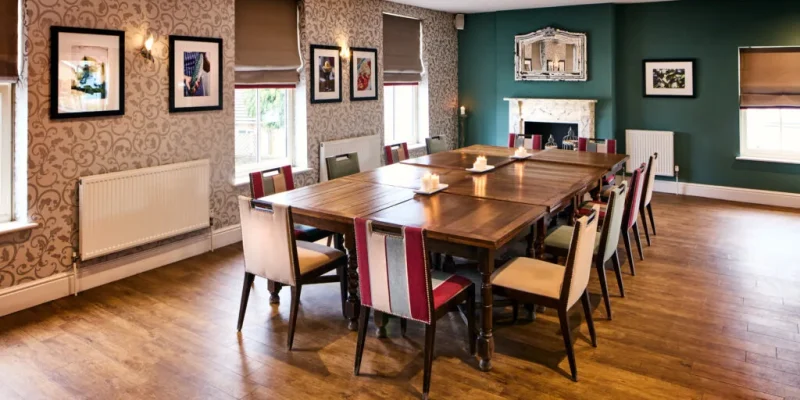Since When Do Corporations Have Their Own Dining Rooms? A Look into Workplace Evolution

The idea of corporations having their own dining rooms may sound extravagant at first, but it’s a growing trend that reflects deeper changes in the modern workplace. If you’ve ever asked, “Since when do corporations have their own dining rooms?” — you’re not alone. From humble beginnings to Silicon Valley-style gourmet cafeterias, the evolution of in-house dining tells a story of productivity, culture, and corporate branding.
In this article, we’ll explore the origins, reasons, and future of corporate dining rooms — and why they might be more than just a workplace perk.
A Brief History: The Origins of Corporate Dining
Corporate dining rooms are not a new concept. In fact, their roots go back to the early 20th century, when major companies like Ford and General Electric began offering cafeteria-style meals to factory workers. These dining spaces were created out of necessity — they were a way to keep workers on-site, reduce time lost to long lunch breaks, and promote employee health.
In post-WWII America, corporate dining became more common in white-collar offices. But it wasn’t until the dot-com boom of the 1990s and early 2000s that in-house dining took on its modern luxury form.
Why Do Corporations Have Their Own Dining Rooms Today?
Now that dining rooms in offices are more common, it raises the question: Why are companies investing in their own food spaces? Here are some strategic reasons:
Productivity and Time Efficiency
Keeping employees on-site minimizes downtime. Employees are more likely to take shorter breaks when food is just steps away.
Employee Well-being and Satisfaction
Healthy, diverse, and free or subsidized meals enhance workplace satisfaction. Companies like Google and Apple set the standard by offering gourmet meals and even dietary-specific options.
Company Culture and Collaboration
Dining rooms act as informal meeting spaces where cross-team collaboration can thrive. Many tech firms design them as open, lounge-style environments to encourage interaction.
Talent Attraction and Retention
In-house dining is a significant perk. It contributes to employer branding and helps recruit top talent who value workplace comfort and convenience.
Crisis Resilience (e.g., Pandemic-Proofing)
During COVID-19, many companies began controlling on-site food services to ensure hygiene, reduce delivery exposure, and maintain workforce health.
Examples of Corporate Dining Innovations
Here’s how some leading corporations are using in-house dining:
- Google: Offers a variety of themed dining areas and gourmet meals, all free.
- Facebook: Has massive dining halls with farm-to-table options.
- Apple: Their Apple Park cafeteria, dubbed “Caffè Macs,” features open-air glass walls, a pizza oven, and global cuisine.
- Amazon: Features sustainable food initiatives and tech-integrated menus.
Even non-tech companies are jumping on board, including law firms, banks, and media houses.
What Are the Benefits of Corporate Dining Rooms?
Here are the top advantages companies gain from offering dedicated dining spaces:
| Benefit | Impact on Business |
| On-site meals | Reduces time wasted off-premises |
| Employee health | Improves wellness, lowers insurance costs |
| Company loyalty | Boosts morale and retention |
| Brand perception | Seen as forward-thinking and caring |
| Community building | Encourages team bonding |
Are There Downsides?
Yes, there are a few considerations:
- Cost: Initial investment and maintenance can be high.
- Space: Not all companies have square footage.
- Management: Requires food safety regulations and staff or catering partnerships.
- Scalability: May work well for large teams but not small startups.
Despite this, many companies find the return on investment (ROI) in productivity and satisfaction justifies the cost.
Setting Up a Corporate Dining Room: Best Practices
If you’re considering implementing one, here are a few tips:
- Survey Employees: Understand dietary preferences, schedules, and interest levels.
- Start Small: Begin with a coffee/snack station or rotating food trucks.
- Partner with Local Chefs or Caterers: Outsourcing meal prep can reduce costs and risks.
- Emphasize Health: Offer nutritious options alongside comfort food.
- Design Matters: Create an inviting space that encourages employees to linger and collaborate.
Future Trends in Corporate Dining
As companies transition into hybrid and remote models, dining experiences may evolve:
- Subscription meal services for remote workers
- Smaller satellite dining areas across campuses
- App-integrated ordering systems for convenience
- Sustainability-first kitchens that reduce waste and support local farms
Expect wellness, personalization, and tech integration to play a central role in future corporate food strategies.
Conclusion
So, since when do corporations have their own dining rooms? Since they realized that food is more than sustenance — it’s strategy. Today’s dining rooms are spaces for productivity, wellness, culture, and connection. As the workplace evolves, so will the way we eat within it.
Whether you’re an HR leader, office manager, or startup founder, understanding the value of workplace dining can give your business a competitive edge.
FAQs
1. Since when have corporations had their own dining rooms?
Corporate dining rooms date back to the early 20th century, initially created to improve worker productivity and health during factory shifts.
2. Why do modern companies invest in corporate dining rooms?
Modern companies use dining rooms to boost productivity, encourage collaboration, improve employee well-being, and attract top talent.
3. Which companies are known for their dining rooms?
Tech giants like Google, Facebook, Apple, and Amazon are known for offering gourmet, on-site dining experiences to employees.
4. Are corporate dining rooms cost-effective?
Yes, many companies find the return on investment worthwhile due to increased productivity, employee retention, and lower health-related costs.
5. What are the future trends in workplace dining?
Trends include app-based food ordering, sustainability-focused kitchens, wellness-based menus, and hybrid-friendly food programs for remote workers.
Also read: Time in Freiburg Germany: 10 Festivals and Events Worth Planning Around











